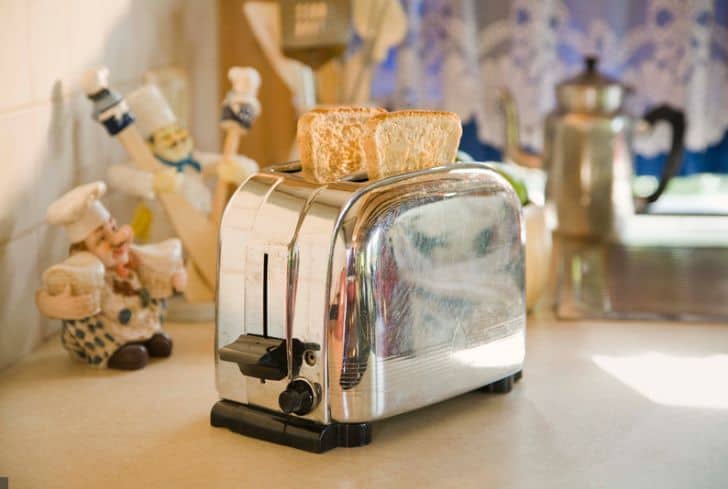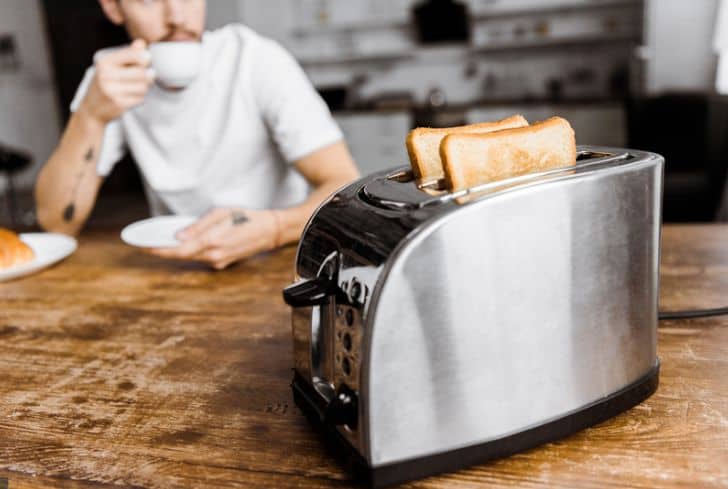Does a toaster consume a lot of electricity? It is no secret that breakfast is the most important meal of the day, and toast is an easy, healthy (arguably), and fast solution. Eighty percent of Americans likely know this because the statistics regarding consumers who own a toaster is beyond impressive.
In the United States alone, the toaster consumer industry rang in huge numbers, up to three billion dollars in sales. Suppose you own or desire to purchase a toaster. In that case, you will naturally get curious about the energy consumption of this device, considering that you will likely use it every other day.
So, how many amps does a toaster use? These gadgets consume six times less energy than the regular oven, so you may be making a great buying decision. Find out more below!
How Many Amps Does a Two-Slice Toaster Use?
A two-slice toaster uses 4 amps of energy for each hour that you use it. The average toaster will cook your bread slices to perfection within five minutes; this means you can prepare at least twelve batches before using up the allocated four amps.
When you think of it, a toaster is a god-sent device because it helps you save money in multiple ways. You will cut back on a few bucks by providing a healthy breakfast before taking on the day’s work.
The energy consumption or requirement for regularly using your toaster is almost negligible; it has one of the lowest power ratings among household devices.
You are less likely to finish twenty-four slices of bread in one sitting; this is enough for a family of four. But you and your household will consume fewer pieces in many cases.
Therefore, you will use less than four amps in the pursuit of breakfast when using a two-slice toaster. You will need to toast bread at least six times with a two-slice toaster to use up the four amps dedicated to this device.
Note that this is the electricity consumption calculated hourly for the average toaster. There will be variations depending on additional features, models, and brands. The best way to confirm how many amps your two-slice toaster uses is to check the structure. The manufacturer always indicates it there.
Chances are you will see the voltage and wattage information rather than the amperage. This is easily resolved.
You can calculate the amperage consumption per hour by dividing the watts by the volts.
How Many Amps Does a Four-Slice Toaster Use?
A four-slice toaster requires more heat energy, using 9 amps per hour. However, this is a larger output, given that these devices will provide your ready-to-eat and delicious slices within five minutes at most. Your four-slice toaster will prepare 48 pieces before it uses up its allocated nine amps.
The size of your kitchen appliance often depends on your household size. There is no use purchasing a four-slice toaster if you live alone.
But if that is how you roll, you will toast at least forty-eight slices of bread before using nine amps of electricity. Unless you have a large household, it is unlikely that you will finish this amount of bread slices, so you may not use all nine amps in a single day.
A four-slice toaster requires more energy than a two-slice toaster. But again, the output of the former device is higher, so that evens things out at the day’s end.
You can choose a four-slice toaster if two slices of bread are insufficient for a single person’s meal. It will ultimately help you save more on energy bills.
How Many Amps Does an Oven Use?
An oven uses a reasonably significant number of amps, considered high even for kitchen appliances. For every hour that it runs, it consumes 4 to 20.8 amps.
Electric ovens are essential, whether small or large, fancy or basic. Just look at the statistics for the sale of cookers and ovens globally. It exceeds 80 billion US dollars.
We are all using it; it is safe to assume. But with its versatility and use cases comes a significant energy consumption.
Thermal energy is a notorious drainer of electricity because of the process of heat conversion. It is called radiation, and it requires a considerable amount of energy.
Throw in additional features, and you can expect more amps to be drawn. This is why it is best to check your product; its model may draw fewer amps than your neighbor’s.
The wattage and voltage are important information you need to determine yours. When you find the missing data, divide the wattage (may be indicated as watts) by the voltage (often 240 volts).
Electric ovens use between 1,000 to 5,000 watts of electrical currents. Let’s assume you have a large family and need a larger range (the larger the box, the more heat is consumed). If it draws 5,000 watts, let’s divide the value by 240 volts.
That’s 20.8 amps for each hour.
But of course, yours may not be this large. This is why it is best to calculate it yourself. Moreover, it may also be a single oven, which will draw less (13 amps).

Factors That Contribute to The Toaster’s Amps
If your toaster seems to be drawing more energy than what you’re accustomed to, there must be some change in the dynamics. In other words, the power consumption depends on varying factors, such as the size of the device, the model, and additional features like temperature settings.
Your toaster’s amp may differ from your friend’s because the models are different, even if the brands are the same. The best way to confirm how many amps your toaster uses is by checking the manufacturer’s instructions.
Moreover, you should know the factors contributing to the toaster’s amps. The first is the size.
Of course, a smaller toaster will consume fewer amps than a large one. The difference between a two-slice toaster and a four-slice toaster may be double the energy consumption because it requires double the heat transfer and conversion.
But again, manufacturers are exploring energy conservation techniques and may succeed at applying them to their products.
The model is another interesting factor. An older model will consume less because it has fewer bells and whistles. However, when you consider the energy-saving capacity of newer brands that are bothered to include this feature, your older toaster may draw unnecessary energy.
Temperature settings are also important. The higher the heat output, the more energy will be consumed.
Do Toasters Use a Lot of Electricity?
No, toasters do not use a lot of electricity compared with other household appliances. It uses between 4 to 9 amps per hour. The average two-slice oven draws 1200 watts of electricity and, calculated in kilowatts per hour, leads to a consumption of 1.2kWh daily, and that is when you use the device for up to one hour (it takes way less to toast bread!)
Monthly, you use 36 kWh at this rate. Again, it will be less because your toaster only needs to run for part of the hour to produce tasty bread.
This is less energy consumption compared to a refrigerator, dryer, and oven range. At the end of the month, your toaster may not rack in a heavy bill.
Can I Use a Toaster With a Generator?
It depends, but running your toaster (a two-slice toaster) with a generator should be fine. The most important thing is that the machine provides enough electricity to avoid causing a short circuit for the toaster.
Typically, toasters draw minimal wattage compared to other electrical devices in the home, and a generator may be able to work with larger appliances like your refrigerator and iron. But, of course, it depends on the size and capacity of the generator.
A smaller one may be unable to power these devices, but a toaster will be fine. Smaller generators can produce up to 4,000 watts, much more than a toaster needs.
In cases like this, the obvious solution is to reduce the appliances relying on your generator before using the toaster. Since the toaster does not require too long to produce delicious slices of bread, you will be in and out in no time.
But should you use a four-slice toaster with a generator? You can, as long as its watts reading does not exceed the wattage capacity of the generator.
Do Toasters Consume Power When Plugged in But Turned Off?
According to the US Department of Energy, 75 percent of home appliances do, including toasters. This is called a phantom load.
Appliances like toasters, lamps, coffee makers, and even your desktop computer draw minimal energy when plugged in but inactive. So, turn off your toaster when you are not using it.
Conclusion
A toaster is a convenient device if you want to avoid missing breakfast too often because you can use it every other day. There are also various recipes you can try, and it would interest you to know that the energy consumption is quite friendly.






